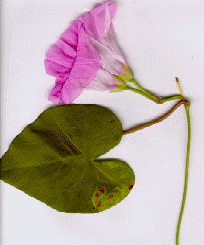

Family: Convolvulaceae (Morning Glories)
Kosrae: oa
Mwoakilloa: soan oahp
Pingalap: oahp
Pohnpei: omp
Chuuk: ruke, rukuruk
Namoluk: rokurok, imwen uut
Etal: imwan úút
Puluwat: rhaiwal
Namonweito: rheiwal
Used for boil (Chuuk: mach, Kosrae: facf, Pohnpei: umpwos or mwpwos, Yap: lot). Brings the boil to a head, resolving the boil faster.
Kosrae. Shrue Kilafwasru. The leaves can be squeezed into water, two drops of coconut milk added, and then drunk to treat productive deep chest cough. Leaves can also be used to treat sunburn in babies. September 2005
Also used in "love magic". - Irá me Neenieer noacute;n Chuuk, East-West Center, 1996.
Shrue Eleshe: Skin rash can be treated by pounding the leaves and applying the juice to the rash. Pound and squeeze the leaves on the head for headache. The same leaf juice added to a few drop of oil and combed into your hair will also make your hair black, long, and strong. You should apply this to your hair prior to sunrise or after sunset only. February 2004.
Francisca Sohl: Small young leaves can be appied to boils to help resolve boils. Women pregnant in the ninth month should chew four or six (but not five) of the young growing tip end of a stem. The tendrils are used in an unspecified way to strenthen the bonds between lovers, bring them together. A saying is associated loosely with this: The bond of marriage is thin and fragile while the bond to children is not easily broken. There seemed to be the inference that omp has a part that breaks easily like the bond of marriage, another part that does not break easily, like that of parent to child. February 2004.
Climbing vine
Leaves: simple, alternate blade cordate, rarely loped, 2-10 cm long.
Flower: axillary, up to 7 cm long.
Calyx: 5 unequal, oblong to suborbicular sepals, 6-10 mm long.
Corolla: funnel form, lavander, 5-loped, 3-4.5 cm long.
Stamens: 5 stamens, ovary superior, contains 4 seeds.
Specimen collected and web page created by: Darwin Peter, October 1998.
Note: the Pohnpeian word tahpw is not confirmed as a name for this plant in any of the sources held by the author. Tuhke en Pohnpei, East-West Center 1992; Ethnobotany of Pohnpei, NYBG 2009; Checklist of the Vascular Plants of Pohnpei, Allertonia, 2010; and Pohnpei Primary Health Care Manual, 2010; all list Ipomea littoralis as omp. The on line Pohnpei dictionary concurs with omp. In contrast, tahpw is listed only as a non-specific generic name for unspecified vines. No other source includes a reference to the term tahpw. Note too the progression in the name of the plant as one moves from Kosrae to the east towards Pohnpei. Note too the Mwoakillese word soahn is the Pohnpeian word tehn or leaf.
Omp is associated with the phrase, "Sahl en pwoapwoaud kin mwei, sahl en neitik soh.
"Omp is associated with the proverb because just as the bond of marriage may be easily broken, so the thin stems of this morning glory vine are fragile. In contrast, the bonds between a mother and child or father and child are not so easily broken. The tendrils of the omp vine are collected by the forlorn lover who desires to be reunited with his or her lover." - Tuhke en Pohnpei, 1992.
Ethnoherb • Ethnobotany • Herbarium • Botany • Work • COMFSM